
The Royal London Hospital is a large teaching hospital in Whitechapel in the London Borough of Tower Hamlets. It is part of Barts Health NHS Trust. It provides district general hospital services for the City of London and Tower Hamlets and specialist tertiary care services for patients from across London and elsewhere. The current hospital building has 1248 beds and 34 wards. It opened in February 2012.
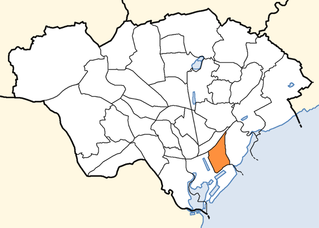
Splott is a district and community in the south of the city of Cardiff, capital of Wales, just east of the city centre. It was built up in the late 19th century on the land of two farms of the same name: Upper Splott and Lower Splott Farms. Splott is characterised by its once vast steelworks and rows of tightly knit terraced houses. The suburb of Splott falls into the Splott electoral ward.
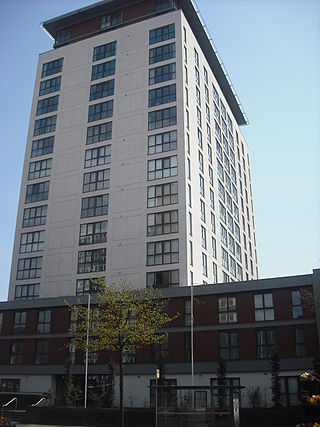
Adamsdown is an inner city area and community in the south of Cardiff, the capital city of Wales. Adamsdown is generally located between Newport Road, to the north and the mainline railway to the south. The area includes Cardiff Prison, Cardiff Magistrates' Court, Cardiff Royal Infirmary, a University of South Wales campus, and many streets of residential housing. There are two primary schools in the area Adamsdown Primary School and Tredegarville Primary School.

The Liverpool Royal Infirmary was a hospital in Pembroke Place in Liverpool, England. The building is now used by the University of Liverpool.

The Countess of Chester Hospital is the main NHS hospital for the English city of Chester and the surrounding area. It currently has 625 beds, general medical departments and a 24-hour accident and emergency unit. It is managed by the Countess of Chester Hospital NHS Foundation Trust, one of the first Foundation Trusts in the UK, formed in 2004. Cardiac rehabilitation services at the hospital are provided by Cheshire and Wirral Partnership NHS Foundation Trust.

Manchester Royal Infirmary (MRI) is a large NHS teaching hospital in Chorlton-on-Medlock, Manchester, England. Founded by Charles White in 1752 as part of the voluntary hospital movement of the 18th century, it is now a major regional and national medical centre. It is the largest hospital within Manchester University NHS Foundation Trust, and based on its Oxford Road Campus in South Manchester where it shares a site with the Royal Manchester Children's Hospital, Manchester Royal Eye Hospital and Saint Mary's Hospital as well as several other educational and research facilities. The Hospital is also a key site for medical educational within Manchester, serving as a main teaching hospital for School of Medical Sciences, University of Manchester.

The Western General Hospital is a health facility at Craigleith, Edinburgh, Scotland. It is managed by NHS Lothian.

The Royal Victoria Hospital commonly known as "the Royal", the "RVH" or "the Royal Belfast", is a hospital in Belfast, Northern Ireland. It is managed by the Belfast Health and Social Care Trust. The hospital has a Regional Virus Centre, which is one of the four laboratories in the United Kingdom on the World Health Organization (WHO) list of laboratories able to perform PCR for rapid diagnosis of influenza A (H1N1) virus infection in humans.

University Hospital of Wales (UHW), also known as the Heath Hospital, is a 1,080-bed hospital in the Heath district of Cardiff, Wales. It is a teaching hospital of Cardiff University School of Medicine. Construction started in 1963, and the official opening took place in 1971. It was Europe's first fully integrated hospital and medical school, at a cost of £22 million. It is the third largest university hospital in the UK, and the largest hospital in Wales. The hospital was previously managed by Cardiff & Vale NHS Trust. In 2009 the Trust was dissolved and the hospital is now managed by Cardiff and Vale University Health Board.

Matron is the job title of a very senior or the chief nurse in several countries, including the United Kingdom, and other Commonwealth countries and former colonies.
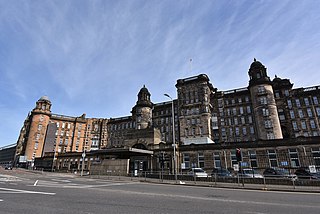
The Glasgow Royal Infirmary (GRI) is a large teaching hospital. With a capacity of around 1,000 beds, the hospital campus covers an area of around 8 hectares, and straddles the Townhead and Dennistoun districts on the north-eastern fringe of the city centre of Glasgow, Scotland. It is managed by NHS Greater Glasgow and Clyde. It was originally opened in 1794, with the present main building dating from 1914, with a major extension completed in 1982.

The Bristol Royal Infirmary, also known as the BRI, is a large teaching hospital in the centre of Bristol, England. It has links with the nearby University of Bristol and the Faculty of Health and Social Care at the University of the West of England, also in Bristol.
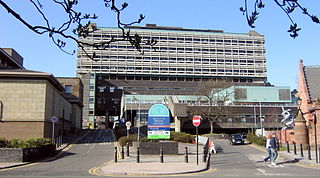
The Western Infirmary was a teaching hospital situated in Yorkhill in the West End of Glasgow, Scotland, that was managed by NHS Greater Glasgow and Clyde. It was opened in 1874 and closed in 2015.

The Radcliffe Infirmary was a hospital in central north Oxford, England, located at the southern end of Woodstock Road on the western side, backing onto Walton Street.

A dispensary is an office in a school, hospital, industrial plant, or other organization that dispenses medications, medical supplies, and in some cases even medical and dental treatment. In a traditional dispensary set-up, a pharmacist dispenses medication per the prescription or order form. The English term originated from the medieval Latin noun dispensaria and is cognate with the Latin verb dispensare, 'to distribute'.

Whitchurch Hospital was a psychiatric hospital in Whitchurch, an area in the north of Cardiff. It was managed by the Cardiff and Vale University Health Board. The hospital remains a grade II listed building. Its grounds are separately listed, also at Grade II, on the Cadw/ICOMOS Register of Parks and Gardens of Special Historic Interest in Wales.
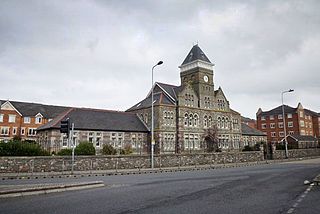
St David's Hospital is a health facility in Canton, Cardiff, Wales. It is managed by the Cardiff and Vale University Health Board. The original main block is a Grade II listed building.

Leith Hospital was situated on Mill Lane in Leith, Edinburgh, and was a general hospital with adult medical and surgical wards, paediatric medical and surgical wards, a casualty department and a wide range of out-patient services. It closed in 1987.

The Bolton Royal Infirmary was an acute general hospital in Chorley Street, Bolton, Greater Manchester, England.

Greenock Royal Infirmary was a health facility in Greenock, Scotland. Its original Hospital or Infirmary of 1809 stood in Inverkip Street, it was subsequently extended round into East Shaw Street, then in 1869 a new building on the adjacent site at 2 Duncan Street formed the main address of the Hospital and Infirmary. It was renamed the Greenock Royal Infirmary in 1922.






















